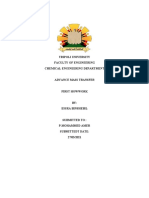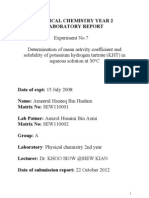0 ratings0% found this document useful (0 votes)
12 viewsExp 11
Exp 11
Uploaded by
Danielle StephensThis document contains questions and calculations related to an experiment on colligative properties and freezing point depression.
1) It provides the equations and calculations to determine the freezing point depression and identify the solution with the greater depression based on the amounts of solute and solvent.
2) It includes the procedure and calculations to determine the molar mass of an unknown solute based on measuring its freezing point depression in cyclohexane.
3) Potential sources of error are discussed, such as measuring a higher temperature than the true freezing point or solvent loss, which could result in an overestimation of the amount of solute or underestimation of the freezing point depression.
Copyright:
© All Rights Reserved
Available Formats
Download as DOCX, PDF, TXT or read online from Scribd
Exp 11
Exp 11
Uploaded by
Danielle Stephens0 ratings0% found this document useful (0 votes)
12 views2 pagesThis document contains questions and calculations related to an experiment on colligative properties and freezing point depression.
1) It provides the equations and calculations to determine the freezing point depression and identify the solution with the greater depression based on the amounts of solute and solvent.
2) It includes the procedure and calculations to determine the molar mass of an unknown solute based on measuring its freezing point depression in cyclohexane.
3) Potential sources of error are discussed, such as measuring a higher temperature than the true freezing point or solvent loss, which could result in an overestimation of the amount of solute or underestimation of the freezing point depression.
Original Description:
Experiment 11 solutions.
Original Title
exp11
Copyright
© © All Rights Reserved
Available Formats
DOCX, PDF, TXT or read online from Scribd
Share this document
Did you find this document useful?
Is this content inappropriate?
This document contains questions and calculations related to an experiment on colligative properties and freezing point depression.
1) It provides the equations and calculations to determine the freezing point depression and identify the solution with the greater depression based on the amounts of solute and solvent.
2) It includes the procedure and calculations to determine the molar mass of an unknown solute based on measuring its freezing point depression in cyclohexane.
3) Potential sources of error are discussed, such as measuring a higher temperature than the true freezing point or solvent loss, which could result in an overestimation of the amount of solute or underestimation of the freezing point depression.
Copyright:
© All Rights Reserved
Available Formats
Download as DOCX, PDF, TXT or read online from Scribd
Download as docx, pdf, or txt
0 ratings0% found this document useful (0 votes)
12 views2 pagesExp 11
Exp 11
Uploaded by
Danielle StephensThis document contains questions and calculations related to an experiment on colligative properties and freezing point depression.
1) It provides the equations and calculations to determine the freezing point depression and identify the solution with the greater depression based on the amounts of solute and solvent.
2) It includes the procedure and calculations to determine the molar mass of an unknown solute based on measuring its freezing point depression in cyclohexane.
3) Potential sources of error are discussed, such as measuring a higher temperature than the true freezing point or solvent loss, which could result in an overestimation of the amount of solute or underestimation of the freezing point depression.
Copyright:
© All Rights Reserved
Available Formats
Download as DOCX, PDF, TXT or read online from Scribd
Download as docx, pdf, or txt
You are on page 1of 2
Expt 11 questions
*Note: I have the 10
th
Edition, so the questions might be different from the 9
th
Edition.
Prelab:
1.
a. Colligative properties are the properties of a solvent that depend on the concentration
of solute particles dissolve in it.
b. 0.01 mol of CaCl
2
has the greatest effect on the colligative properties for a given mass of
pure water because it has three particles
2. Water from an underground aquifer probably has more minerals dissolved in it, so it will have a
lower (depressed) freezing point than the glacier.
3. Calculations:
Delta T = k
f
* m * i
Solution A: 0.0154 kg solvent, 0.14 g solute, molar mass M, k
f
= 9.1
Delta T = (9.1)*(0.14/M)*(1/0.0154)
= 82.73 / M
Solution B: 0.0127 kg solvent, 0.17 g solute, molar mass M, k
f
= 6.55
Delta T = (6.55)*(0.17/M)*(1/0.0127)
= 87.677 / M
Therefore, B has the greater freezing point change
4.
a. Four
b. Cooling curve for cyclohexane, cooling curve for cyclohexane plus unknown solution.
This tells us the freezing point and freezing point difference (depression) when adding
more solute.
5.
a. A
i. Mass of cyclohexane in solution = 0.01014 kg
ii. Delta T = k
f
* m * i
3.04 = 20 * (moles / 0.010385 kg)
Moles = 0.00158
Therefore, moles of solute = 0.00158 mol
iii. Mass of solute in solution = 0.255 g
iv. Molar mass of solute = 0.255 g / 0.00158 mol = 161.392 g / mol
b. Average molar mass of solute = (161.392 + 151 + 143) / 3 = 151.797 g / mol
c. SD = sqrt( (151.797 -161.392)^2 + (151.797 151)^2 + (151.797 143)^2 ) / (3-1)
= 9.222 g / mol
%RSD = (9.222 / 151.797) * 100
= 6.075%
Lab Questions:
2. The reported moles of solute will be too high because, using the equation Delta T = k
f
* m, if the
recorded temperature is higher, then the moles of solute will be greater.
4. This loss of cyclohexane will result in the freezing point of the solution being recorded as too low
because, using the equation Delta T = k
f
* m, if the amount of cyclohexane is lower, the molality (mol of
solute / mass of solvent) will be lower, so Delta T will be lower.
5. The dissociation of the solute will affect the reported molar mass as too high because its mass was
measured on the scale before it started dissociating in the solution.
You might also like
- Tripoli University Faculty of Engineering Chemical Engineering DepartmentDocument9 pagesTripoli University Faculty of Engineering Chemical Engineering DepartmentSrewaBenshebilNo ratings yet
- Determination of Mean Astivity Coefficient and Solubility of Potassium Hydrogen Tartrate (KHT) in Aqueous Solution at 30ºCDocument9 pagesDetermination of Mean Astivity Coefficient and Solubility of Potassium Hydrogen Tartrate (KHT) in Aqueous Solution at 30ºCAmeerul Hazeeq100% (10)
- Colligative Properties and AnswerDocument3 pagesColligative Properties and AnswerTai PanNo ratings yet
- Chapter 13 Properties of Solutions Exercise 1Document26 pagesChapter 13 Properties of Solutions Exercise 1janeNo ratings yet
- CHEMISTRY Lecture NotesDocument83 pagesCHEMISTRY Lecture NotesClifford Zharare100% (1)
- Chemistry Lecture NotesDocument83 pagesChemistry Lecture NotesMudathir AyomideNo ratings yet
- Worksheet 9 117 AnswersDocument2 pagesWorksheet 9 117 AnswersMaxiNo ratings yet
- FinalDocument17 pagesFinalMatt Pribadi100% (1)
- WK4 Umbao L Cana GC2Document5 pagesWK4 Umbao L Cana GC2Master Of BlankNo ratings yet
- Solutions: Lecture NotesDocument14 pagesSolutions: Lecture NotesMisa AmaneNo ratings yet
- BE NumericalsDocument6 pagesBE Numericals1ms20ei002No ratings yet
- Minimum Learning Material Class 12Document15 pagesMinimum Learning Material Class 12stuakatharsaaNo ratings yet
- 02 Handout 2 240404 084627Document3 pages02 Handout 2 240404 084627thea komodoNo ratings yet
- Tugas Latihan TitrasiDocument9 pagesTugas Latihan TitrasithomasdarmaNo ratings yet
- ChemTeam - Molality Problems #1-15Document10 pagesChemTeam - Molality Problems #1-15Abby MartinezNo ratings yet
- 0.5 Pretest Day2Document15 pages0.5 Pretest Day2Janica Palangeo100% (1)
- Solutions NumericalsDocument3 pagesSolutions Numericalsdevesh saiNo ratings yet
- Tugas Volume Molar Dan Termo CmpuranDocument6 pagesTugas Volume Molar Dan Termo CmpuranHeppy Yessya100% (1)
- The Mole FractionDocument6 pagesThe Mole Fractiona.zaghariNo ratings yet
- Himmeblau Chp1 (WWW - Myuet.net - TC)Document23 pagesHimmeblau Chp1 (WWW - Myuet.net - TC)redj288No ratings yet
- DAHILOG Chemistry Quiz PART 2Document5 pagesDAHILOG Chemistry Quiz PART 2Ybur Clieve Olsen DahilogNo ratings yet
- TD Chimie CorrectionsDocument8 pagesTD Chimie Correctionslohan.soaresNo ratings yet
- Solved Numericals-2Document10 pagesSolved Numericals-2Nishant KeswaniNo ratings yet
- Adsorption & Ion Exchange ProblesmDocument10 pagesAdsorption & Ion Exchange ProblesmDeepak KanjwaniNo ratings yet
- Answers Mock TestDocument8 pagesAnswers Mock TestTamanna PuniaNo ratings yet
- 01 Petrucci10e SSM PDFDocument16 pages01 Petrucci10e SSM PDFJayvee GayosoNo ratings yet
- Chemistry IA-1 Finding Molar Mass of ButaneDocument2 pagesChemistry IA-1 Finding Molar Mass of ButaneRuhaan ZaveriNo ratings yet
- Problem 1.1ADocument23 pagesProblem 1.1AJohnathan Ortega MenesesNo ratings yet
- Mol AlityDocument9 pagesMol AlityChristianPaulSanchezSamog-oyNo ratings yet
- Colligative Properties.: Unit 4Document52 pagesColligative Properties.: Unit 4RafaelNo ratings yet
- GEO Written Examination of General and Inorganic ChemistryDocument2 pagesGEO Written Examination of General and Inorganic ChemistryAnna ScamardellaNo ratings yet
- Tugas RutinDocument15 pagesTugas RutinElvi ZurryyatiNo ratings yet
- 5321 Exam ReviewDocument20 pages5321 Exam ReviewhkumosesmedNo ratings yet
- A. Multiple ChoiceDocument8 pagesA. Multiple ChoicenerosituNo ratings yet
- Exercise 4Document32 pagesExercise 4Mas IzyanNo ratings yet
- Tugas Latihan TitrasiDocument9 pagesTugas Latihan TitrasithomasdarmaNo ratings yet
- Chem 11Document5 pagesChem 11Jen Karen BolidoNo ratings yet
- Boiling Point ElevationDocument23 pagesBoiling Point Elevationopolla nianorNo ratings yet
- Chee Assignment 1Document13 pagesChee Assignment 1TSHEGOFATSO GOTSILENGNo ratings yet
- Cpp-Liquid Solution-Pkd - VKTDocument6 pagesCpp-Liquid Solution-Pkd - VKTVIVEK KUMARNo ratings yet
- NCERT Solutions Class 12 Chemistry Chapter 2 SolutionsDocument31 pagesNCERT Solutions Class 12 Chemistry Chapter 2 SolutionsVidyakulNo ratings yet
- Stem08 Final LessonDocument22 pagesStem08 Final Lessonsunooyah95No ratings yet
- Class Test SolutionDocument10 pagesClass Test SolutionAkash GoelNo ratings yet
- Solution Manual For General Chemistry 10th Edition by Ebbing PDF Download Full Book With All ChaptersDocument45 pagesSolution Manual For General Chemistry 10th Edition by Ebbing PDF Download Full Book With All Chaptersramuuneau100% (7)
- Problems With Solutions Week 2 For StudentsDocument6 pagesProblems With Solutions Week 2 For StudentsNazym TurkebayNo ratings yet
- Experiment No4Document7 pagesExperiment No4MARISSE LYN DORADONo ratings yet
- Science - Analytical ChemistryDocument7 pagesScience - Analytical Chemistrykeanbermudez52No ratings yet
- Physical Chemistry Competency ExamDocument2 pagesPhysical Chemistry Competency ExamRaymond YabutNo ratings yet
- DAHILOG Chemistry ACTIVITY ON SOLUTIONSDocument7 pagesDAHILOG Chemistry ACTIVITY ON SOLUTIONSYbur Clieve Olsen DahilogNo ratings yet
- ANALYTICAL CHEM LEC 3 - Unit 2, Chapter 2 (Sample Problems)Document3 pagesANALYTICAL CHEM LEC 3 - Unit 2, Chapter 2 (Sample Problems)ARRIANE CYREL CAMACHONo ratings yet
- Rmf8e Ism-Ch01 Pp1-27 CRCDocument27 pagesRmf8e Ism-Ch01 Pp1-27 CRClvravestein1No ratings yet
- Waste Midterm PlateDocument15 pagesWaste Midterm PlateHannah Rachel UlepNo ratings yet
- CH 2Document43 pagesCH 2TechView TeamTamilNo ratings yet
- Previous HSE Questions and Answers of The Chapter "SOLUTIONS"Document97 pagesPrevious HSE Questions and Answers of The Chapter "SOLUTIONS"ABDUL RAZACKNo ratings yet
- Colligative Properties NotesDocument5 pagesColligative Properties Notesjehov cantera100% (1)
- CHEM 102 Tutorial 5 SolutionsDocument2 pagesCHEM 102 Tutorial 5 SolutionsMatty MontshoNo ratings yet
- 18 - 70 Heppy Yessya PutriDocument6 pages18 - 70 Heppy Yessya PutriHeppy YessyaNo ratings yet
- Analytical Modeling of Solute Transport in Groundwater: Using Models to Understand the Effect of Natural Processes on Contaminant Fate and TransportFrom EverandAnalytical Modeling of Solute Transport in Groundwater: Using Models to Understand the Effect of Natural Processes on Contaminant Fate and TransportNo ratings yet



























































